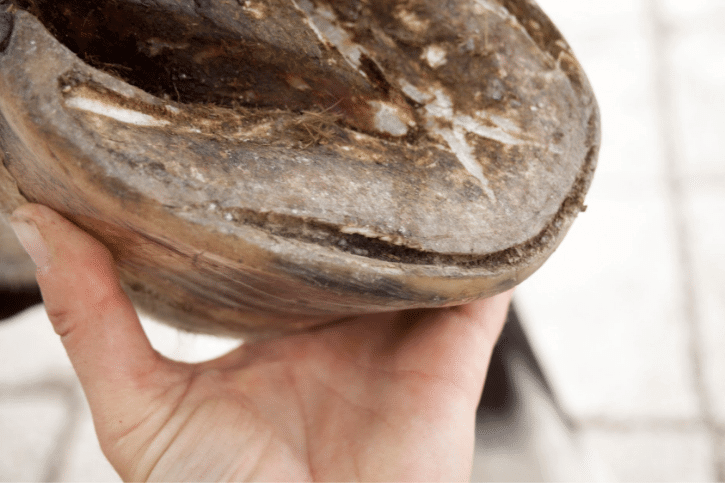Can You Ride A Horse With White Line Disease?
As horseback riders, the health and wellbeing of our horses should always be our number one concern from day to day.
Riding an unhealthy horse is never a good idea for either the horse or the rider, and hoof infections and diseases are, naturally, one of the worst things that cann happen to a riding horse.
One of my horses, unfortunately, recently contracted white line disease in one of its hooves.
I didn’t think I’d be able to safely ride her anymore, but just to be sure, I decided to look into it.
So, can you ride a horse with white line disease?
Riding a horse with white line disease is not a good idea. Given that the condition affects the hooves so heavily, the chances of putting excessive stress on the hoof is very high. This is dangerous for both the horse and the rider. It will not be able to support your weight as well, and could lose balance.
While white line disease has levels of severity, it’s generally not a good idea to ride your horse while it has any kind of hoof infection.
The chances of making it worse are very high.
With that in mind, let’s take a closer look at this question.
Is white line disease painful?
Obviously, there are always levels of severity with infections like white line disease.
Some cases may be very mild, and the horse will barely notice.
However, as a rule of thumb, yes, white line disease is painful for horses.
The initial stages of the infection will not be painful, and if you or a farrier can identify the problem during these stages, it can be swiftly treated, and any serious pain can be avoided.
If you’re wondering, though, whether your horse will be in more pain with white line disease if you ride it, then the likely answer is yes.
Given that it’s a hoof infection that can even break down the integrity of the hoof wall, it will make your horse footsore; carrying your extra weight will make this worse.
Can a horse recover from white line disease?
If treated properly and quickly then absolutely a horse can recover from white line disease.
You can’t do it yourself, though, unless you’re a farrier.
You’ll need a specialist to come in.
The fact is, you should always be doing regular spot-checks on the underside of your horse’s hooves.
The farrier will then be able to address the problem by removing the affected tissue.
The farrier will expose the infection by removing the hoof wall above it, clearing out the infection, and repairing the hoof as best as they can.
In cases where it is left untreated for too long, it could make your horse permanently lame.
So, again, if you see any signs of it whatsoever, you should consult a farrier immediately.
The important thing is that you act quickly to prevent it from spreading.
Can I ride my horse with white line disease?
The simple answer is no.
As I said, the initial stages are non-painful, and during this period, your horse may be able to carry you without noticing a problem.
However, it’s just better to play it safe, even at the early stages.
If you think your horse has white line disease, you should stop riding it.
Certainly, do not ride your horse if it has any sort of advanced stage of white line disease.
It will be footsore and putting extra strain on the horse’s hooves will only make the pain worse.
Equally, since white line I particular causes parts of the hoof wall to fall away and break off the horse, riding a horse with the condition stands a serious chance of permanently injuring it.
So, how do I identify it as soon as possible to avoid making this mistake.
How do you know if your horse has white line disease?
As I said, the most important thing is that you are always regularly doing spot checks of the underside of your horse’s hooves.
There are many conditions like white line which can take root in a horse’s hoof, and often the only way to catch them early on is to check under your horse’s hooves.
The area between the exterior hoof wall and the point where it joins the sole is the white line.
If it becomes damaged, bacteria and fungus can enter, and cause infection. So if it appears as though it is infected, cut or seems to be oozing any liquid, then this could be white line disease.
Keep a close eye on your horse’s hooves and you’ll be able to identify it before it’s a problem.
White line disease is no joke, then.
You should take it very seriously, and while your horse shows signs of it, you should not ride it.
Have your farrier come and see the horse as soon as possible to properly diagnose and treat the problem.
Before the horse has fully recovered, do not ride it.
White line disease will, if nothing else, make your horse very footsore, and riding it will only make this worse.
